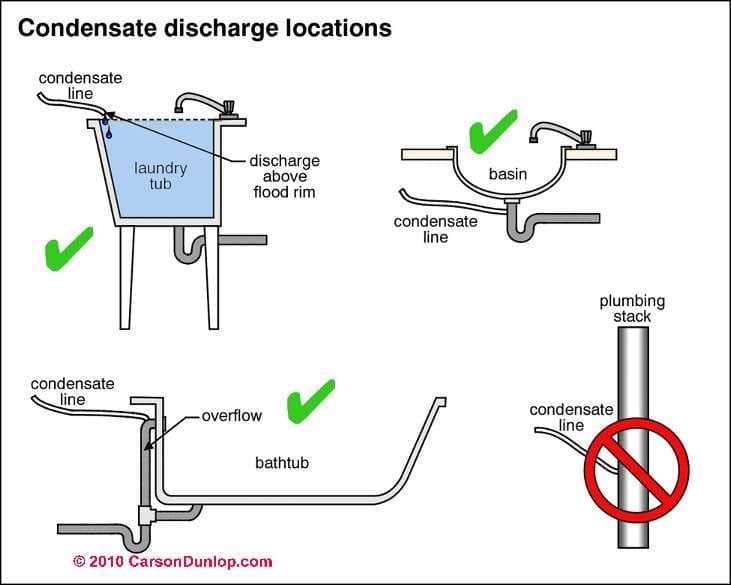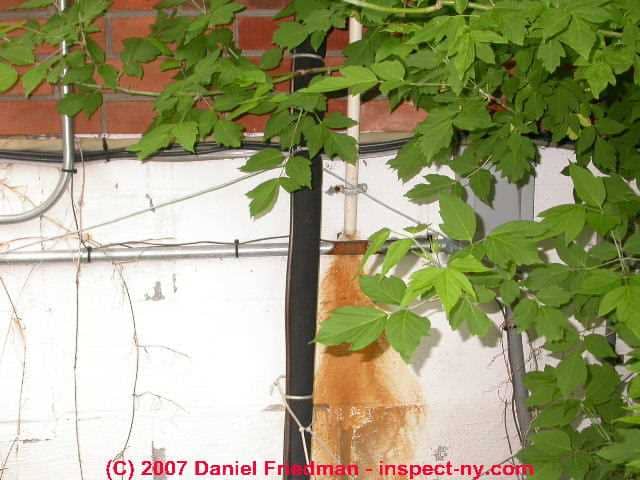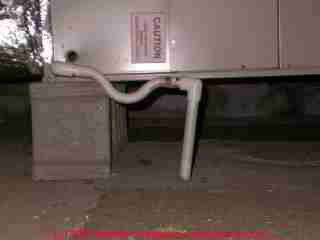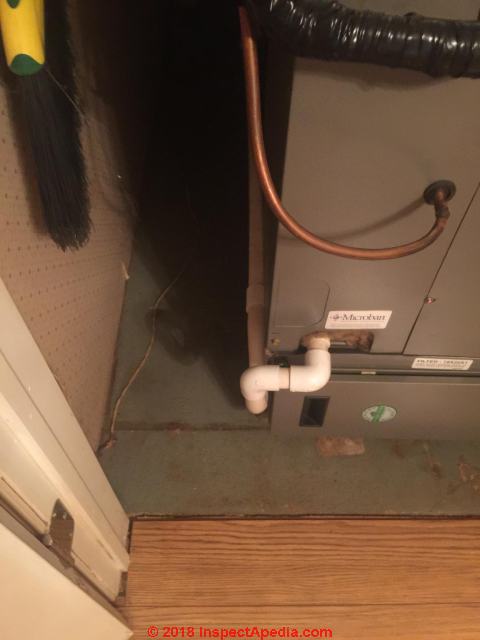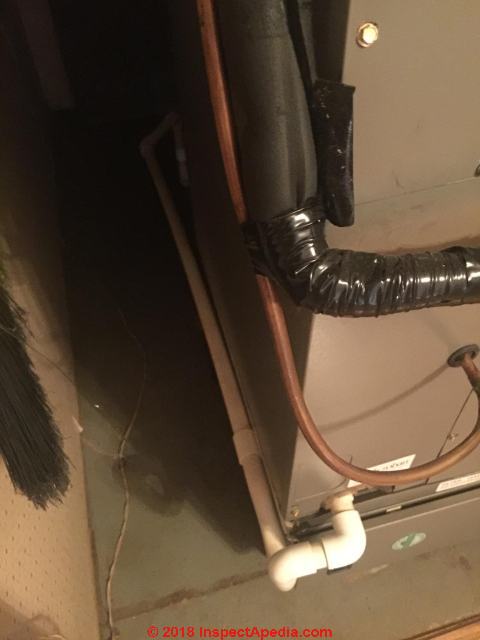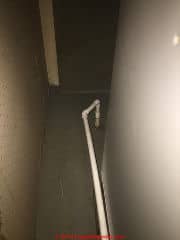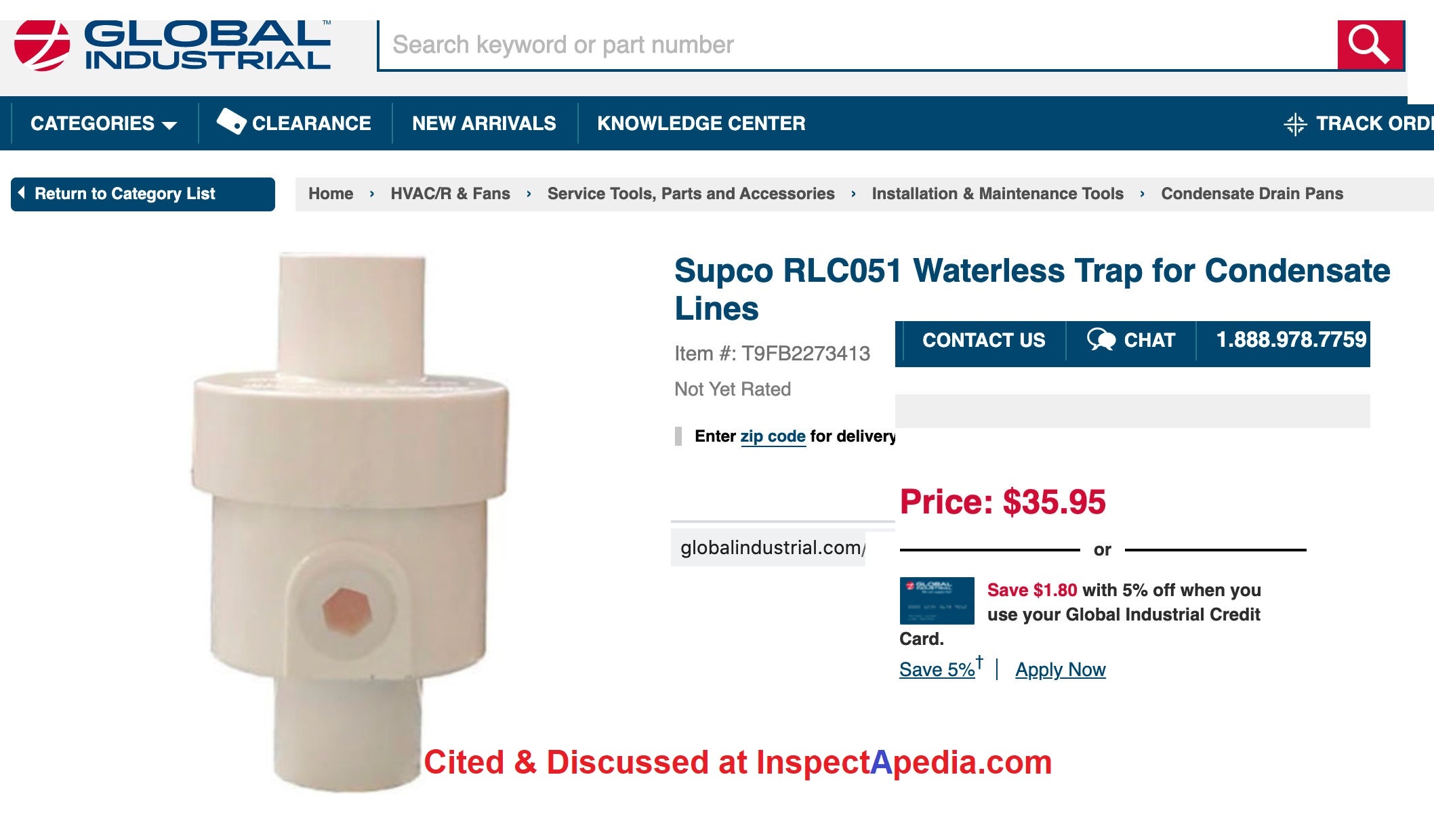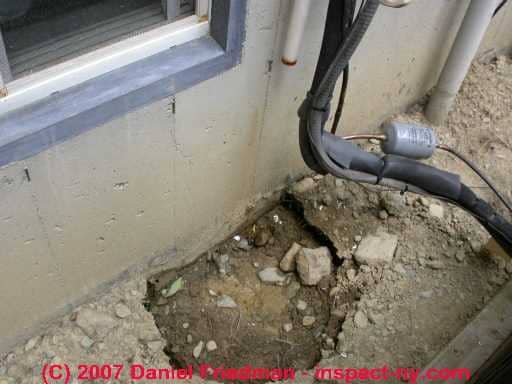 HVAC Condensate Drain & Disposal FAQs
HVAC Condensate Drain & Disposal FAQs
Q&A on Condensate drain installation or functional errors
- POST a QUESTION or COMMENT about air conditioner or heat pump condensate drain installation, leaks, clogs, troubleshooting, repairs
A/C condensate piping, drains & pump questions and answers.
This air conditioning repair article series discusses the inspection and repair or un-clogging of air conditioning condensate systems.
Page top photo: condensate drain drips close to the foundation wall have created a small hole that might direct roof spillage or surface runoff towards the building's basement. Adding a bit of fill and sloping the soil away from the building are the proper repair.
InspectAPedia tolerates no conflicts of interest. We have no relationship with advertisers, products, or services discussed at this website.
- Daniel Friedman, Publisher/Editor/Author - See WHO ARE WE?
Q&A on Disposal of Air Conditioning or Heat Pump Condensate
 These questions & answers about troubleshooting problems with A/C or heat pump condensate drains were posted originally
These questions & answers about troubleshooting problems with A/C or heat pump condensate drains were posted originally
at CONDENSATE DRAIN PROBLEMS - be sure to review that page.
Our photo of condensate piping below a crawl-space mounted air handler shows another ugly condensate disposal method: dump it on to the dirt crawlspace floor.
See details of similar condensate dumping location hazards at CONDENSATE DRAIN to OPEN SEWER LINE
Article Contents
- CONDENSATE DISPOSAL into APPLIANCE DRAIN PAN FAQs - into a water heater or washer leak catch-pan?
- CONDENSATE DISPOSAL INTO PLUMBING FIXTURE FAQs
- CONDENSATE DRAIN BLOCKED or CLOGGED FAQs
- CONDENSATE DRAIN INSULATION FAQs
- CONDENSATE DRAIN REPAIR FAQs - broken or missing, clogs, slope, traps
- CONDENSATE DRAIN SIZE FAQs
- CONDENSATE DRAIN TRAP FAQs
- CONDENSATE NOT DRIPPING INTO DRAIN PAN, FAQs
- DRIPPING NOISE FAQs
- OUTDOOR CONDENSATE DISPOSAL FAQs
...
HVAC Condensate Empties into Sink, Toilet or Tub FAQs
The AC Drain in my apartment drips into my kitchen sink - is that legal?
I live in apartment complex and the AC drain line is directly above my kitchen sink I was wondering if that is a legal hookup it drains into my sink but misses gets a counter splashes everywhere - On 2019-06-05 by Anonymous
Moderator reply: NO
Draining condensate into a sink where food is prepared is unsanitary and unsafe.
Draining condensate into a fixture or onto a surface where it can expose building occupants to bacterial hazards or slip and fal lhazards is improper and unsafe.
Is it Acceptable to dump our A/C sytem condensate onto the shower floor?
I have a question regarding the condensate disposal line on the a.c. system in my rental property.
The condensate drain line is run directly into my shower where it is always a slimy discolored look at the front of my shower.
My landlord did the work on his own some time ago but I have been having some problems with my feet that i never had before.
Iis this an improper place to run the drain line?
Is it proper to place the discharg line from a.c. directly into a shower not the drainpipe of a shower just dripping into the shower? On 2017-07-18 by Eric
Reply by (mod) - No
No Eric that's a bad practice. I'd worry about
- Bacterial hazards - see Legionella BACTERIA & HVAC EQUIPMENTSlippery_Stairs_Walks.php
- Slip and fall hazards - due to the development of algae or mold on the surfaces leading to a slip and fall hazard.
Algae is one of the slipperiest substances known, especially when wet such as on a shower floor - it is very dangerous.
See details at SLIPPERY STAIRS, WALKS, ROOFS
Is it legal or acceptable to drain the air conditioner condensate into a bathtub?
The condensate drain in my daughters apartment drains to her bathtub. In fact hits her right between the eyes when when is soaking. Is this legal of even acceptable practice. On 2019-07-28 by Brian
Reply by (mod) - No
Brian
No; A/C condensate could be unsanitary, unsafe, for example possibly containing legionnaire's disease-causing bacteria.It also can create algae and cause a bad slip and fall injury. See the two hazard links given just above in our answer to Eric's similar question.
The condensate drain ought not be spilling into a plumbing fixture where it can come into contact with a person. - Daniel Friedman
Condensate drains into toilet causing stains and illness
I recently found out that the 2 condos above me are draining their air conditioning condensation pipe into my water closet.
The drain that the pipe is being drained into is really nasty looking, Red ish in color and white crystals are starting to form in the water.
Please help My dog has started coughing over the past 2 years and I have asthma and keep getting really sick. On 2017-08-30 by Jenn
Reply by (mod) -
Sounds odd indeed, to drain other unit's condensate into your toilet, and a possible health hazard. Have you asked your doctor about this concern?
Also you may want help from your local building or plumbing code inspector
Stains on A/C unit drip tray - are these a mold problem?
I keep trying to upload a photo from the rear edge of the drip pan tray when coils were replaced but it won't upload. - Anon: June 18, 2021
Moderator reply:
At ODORS in AIR HANDLERS & DUCT WORK
you will find our email discussion on tracking down ductwork odors and also your photo.
...
Condensate system dripping noise FAQs
We hear a Dripping Sound after the A/C stops running
My AC is located in a closet near the front door, when AC stops running a dripping sound begins about 10 minutes later in the kitchen near the ceiling by the vent stack which about 10 to 12 feet from AC unit is located. AC repair tech say the drain line goes outside.
Is there a secondary drain line that goes to the vent stack.. I have had to raise the temperature on my AC to slow the dripping down. Had 2 leak searches and no one knows where the leak is coming from. No AC on no leaking. I live in Florida you can't live here without AC - On 2020-09-07 by Lynda
Reply by (mod) - risk of clogged condensate drain
Lynda
AC tech may be correct that the condensate drain heads outdoors but that doesn't answer the question of whether or not the drain is clogged, has a dip in the piping, or is otherwise leaking or overflowing to cause condensate dripping in a wall, attic, crawlspace or other location.What's needed as more thorough visual inspection to find the leak. Start of the air handler to look for an overflowing condensate pan.
...
AC Condensate is staining the Building Exterior Wll
My AC is in the attic of my 2 story house. The condensate line terminates about 6 inches out of the exterior wall and it is staining the walls below it 2 floors down.
Do I reroute the line or can I attach PVC lines vertically down where the condensate terminates to avoid staining my walls? - On 2020-04-21 by Lodi Josef -
Reply by (mod) - extend the drain to protect the wall
Lodi
I would extend the drain line down and out as needed to keep condensate off of the building wall.
...
Condensate Drain Size FAQs
Connecting Too Many Condensate & Other Drains to the Floor Drain Caused Flooding
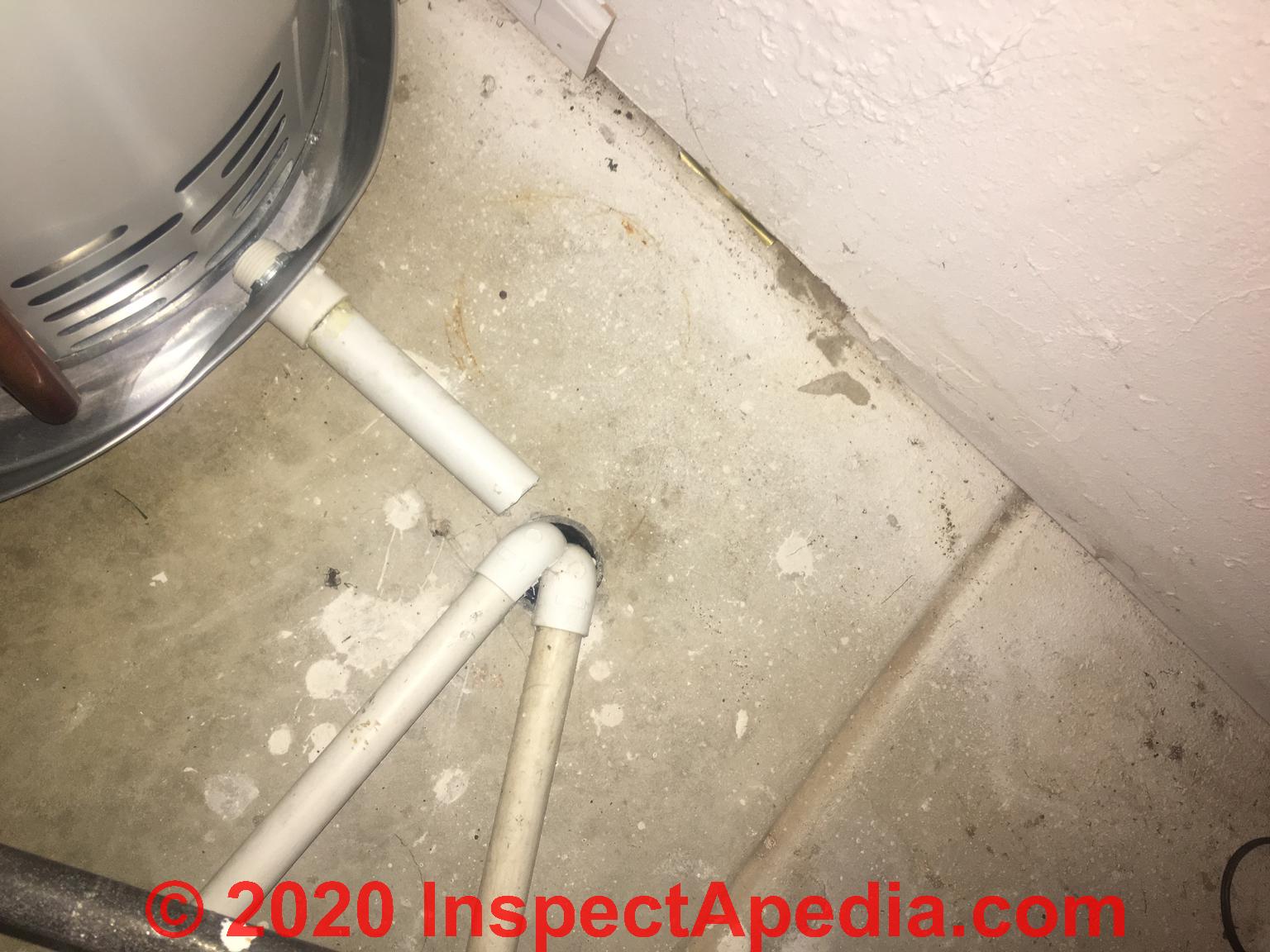 My HVAC condensate has two pipes draining into a single 1.5” floor drain in my basement. HW heater installed a few years ago and does have a drain pan.
My HVAC condensate has two pipes draining into a single 1.5” floor drain in my basement. HW heater installed a few years ago and does have a drain pan.
Unfortunately when the TPRV stuck opened last week we realized that the drain pan just spills on the floor a few inches from the floor drain. Likely because there is no room in the drain.
So I was thinking of running the condensate drains into the pan and the HW pan to the drain. Logic is that if the WH fails there will be a lot faster flow so I want that to flow directly into the floor drain.
So, what are your concerns with the condensate going into the WH pan? Other suggestions?On 2019-07-30 by Jeff
Reply by (mod) -
Jeff,
That idea sounds reasonable but has a couple of concerns about which you can think, investigate, comment further.
1. There must be absolutely NO standing water left in the overflow pan from condensate draining into the pan. Otherwise you risk growth of harmful mold or bacteria such as the legionnaire bacteria problem associated with AC systems.Legionella BACTERIA & HVAC EQUIPMENT https://inspectapedia.com/aircond/Legionella_Prevention_HVAC.php has details.
2. Depending on the support under the water heater that keeps any metal parts off of the overflow / leak pan surface, if the pan is kept constantly wet with A/C condensate there could be rust damage to the water heater bottom.
3. When a water heater is in a basement next to a floor drain and sitting on a concrete floor that slopes to the drain, I'm unclear what benefit is offered by the spill pan under the water heater.Spill pans are placed under water heaters and washing machines when they are installed on an upper floor in a building, principally to catch what should be very rare leaks or spills in time to prevent them from damaging finish flooring in those areas. It sounds to me as if somebody just took a generic " install the pan " approach without much thought.
Or perhaps a local inspector demanded it.
It may make more sense to simply remove the leak pan given it's not contributing anything in your installation and to keep the AC condensate's location draining right into the floor drain.
4. The real danger here that hasn't been addressed is the stuck-open TPR valve.The concern is that the valve may not function as it should in response to a true over-temperature or over-pressure condition, risking a dangerous BLEVE explosion of the water heater.
(Search InspectApedia.com for BLEVE EXPLOSION to read details).
So it may make sense to replace the TPR valve.Followup by Jeff
Thanks for the quick response...I believe the pan is to code. Benefit I see is that if leaks occur they are better contained and can be directed to a drain. In this case the last part was not so well executed on.
Agree on the corrosion concern...
Regarding the relief valve, reading my WH manual, apparently you are supposed to exercise it regularly.
Flicked it a few times and it seems well seated now but will check out what you mentioned.
I’ve attached a picture...if you have any suggestions please let me know
Thanks againReply by (mod) -
Actually I'd leave that installation as it is, PROVIDED that the ends of the AC condensate drains are NOT immersed in the trap water - we want an air gap there.
You're right that TPR valve manufacturers and the manufacturers of appliances on which they're used all advise periodic testing by opening the valve.
It's NOT something to try on a Sunday Night when the plumbing suppliers are closed, as if the valve spits out a washer or otherwise jams internally and keeps spewing water you have to shut down the equipment entirely (as well as turning off its water supply).
Sometimes we can flick the valve lever as you did, OR tap lightly on the valve stem, and it will unstick itself and close properly.
If there is the slightest doubt about a pressure relief valve's reliability it should be replaced.
E.g. if a valve has been dripping or leaking for a long time I've seen so much mineral scale form inside the valve body that it would no longer open in response to an over-pressure or over temperature condition.Watch out: if as your photo suggests, there is a wall cavity that could flood from water heater leaks or drywall that could be wet, then there's a risk of water damage, mold damage, etc. from a water heater spill onto that basement floor; in that case it's better to have the drain pan just as it's shown in your photo.
Followup by Jeff
Yea, the rest of the basement is finished which is why I want to do something should the water heater fail.
I think I am going to extend the output of the drain pan to directly over the floor drain and then mode the condensate lines to smaller diameter tubing so as to fit all three right above the drain
Thanks againReply by (mod) -
At CONDENSATE HANDLING You will find a table of the minimum condensate drain pipe sizes
...
A/C Condenser Unit Condensate Not Flowing into Drain
Condensation in the air handler leaks out into our basement
I just had my A/C serviced yesterday (coils cleaned, gas & refrigerant added.) The reason for the call was because of a condensation problem.
The pipe is clean and the pan is running the way it should. My problem is the condensation is coming from UNDER the A coils.
There are drip "catchers" on both sides and they are very cold, the temperature in the small room the unit is in is hot.
Is it possible that the room is too warm and causing those to condensate?
When the blower kicks on it blows the water all over inside and has been leaking down in the basement. I can't think of anything else that would cause it. On 2012-07-10 by Lena
Reply by (mod) - condensation that forms on the cooling coils should be entirely trapped by the condensate drip pan
Lena, condensation that forms on the cooling coils should be entirely trapped by the condensate drip pan found there.
And yes, a very cold drip tray in a hot moist environment might generate condensation on its sides and bottom where the condensate then drips out of the system. But HVAC equipment designers consider problems like that - I'd ask your HVAC service tech to take a more careful look at the system, as the problem for which you asked for help continues to occur.
Cleaning the coils and adding refrigerant ? I'm not sure how that would have fixed a condensate leak problem unless the tech thought that the cooling coil was forming so much ice that when it melted water leaked out of the system.HVAC equipment does not normally consume refrigerant, so if you had to add refrigerant to your system, it'd be best to find and fix the leak rather than to just keep adding refrigerant.
Condensing coil condensate is not going into the condensate pan and drain
I live in a condo building. I have a leak coming from my inside HVAC unit.
Condensation from the coils appears to be dripping straight down instead of flowing down the coils and into the condensation drain.
I have had two separate HVAC technicians look at the problem.
One thought there was a possible issue with not enough air circulation coming back into the system due to smaller than should be duck work (just a guess on his part as he not seen the duct work) or possible due to a fire damper in the duck work being closed somewhere.
The other technician did not find any specific problems with the unit and suggested that it might be a design and application issue that was beyond the scope of what a field technician can do. What are your thoughts? Mike
Reply by (mod) -
Mike,
Usually the condensate pan inside the air handler extends under the cooling coil to catch any runoff or dripoff, though sometimes in high humidity the blower can blow condensate past the pan.
Inadequate return air flow would slow down air movement across the coils and would not make the problem of condensate missing the pan worse, rather I'd think it'd make it better - unless there is something I just don't get about that explanation.
Make sure that the drip pan pitches towards its drain and the drain is not clogged.Then inspect and maybe if you can, take some photos to send along and I can comment further;
See our detailed guidance
by Mike
Dan,
In response to your comments the cooling coil extends upward at an angle - maybe 45 degrees or less.The drip pan (more of a drip strip) is actually a trough at the bottom of the cooling coil housing. If the condensate runs down the coils to the bottom of the housing, it is captured by the drip pan.
However, when it drips straight down from some of the upper coils, it completely misses the drip pan. Not sure how to attach photos to this response but I do have some that might better illustrate what I am taking about.
...
A/C Condensate Drain Spills into Water Heater or Washer Pan FAQs
Is it OK to Run the condensate drains into the pan and the HW pan to the drain
My HVAC condensate has two pipes draining into a single 1.5” floor drain in my basement.
HW heater installed a few years ago and does have a drain pan. Unfortunately when the TPRV stuck opened last week we realized that the drain pan just spills on the floor a few inches from the floor drain. Likely because there is no room in the drain.
So I was thinking of running the condensate drains into the pan and the HW pan to the drain.
Logic is that if the WH fails there will be a lot faster flow so I want that to flow directly into the floor drain.
So, what are your concerns with the condensate going into the WH pan? Other suggestions? -On 2019-07-30 by Jeff -
Reply by (mod) - concerns with using an appliance leak pan for condensate disposal
Jeff,
That idea sounds reasonable if the appliance leak pan is also connected to a drain, but here are some concerns about which you can think, investigate, comment further.
1. Mold & bacteria hazards:There must be absolutely NO standing water left in the overflow pan from condensate draining into the pan. Otherwise you risk growth of harmful mold or bacteria such as the legionnaire bacteria problem associated with AC systems.
Legionella BACTERIA & HVAC EQUIPMENT has details.
2. Water heater rust damage risk:Depending on the support under the water heater that keeps any metal parts off of the overflow / leak pan surface, if the pan is kept constantly wet with A/C condensate there could be rust damage to the water heater bottom.
3. Leak catch pan may not be needed at all:auxiliary drain pans with a separate drain placed under certain applinaces like water heaters and washing machines are required by some building codes specifically where damage to building components could occur as a result of water overflow from the equipment.
When a water heater is in a basement next to a floor drain and sitting on a concrete floor that slopes to the drain, I'm unclear what benefit is offered by the spill pan under the water heater.
Spill pans are placed under water heaters and washing machines when they are installed on an upper floor in a building, principally to catch what should be very rare leaks or spills in time to prevent them from damaging finish flooring in those areas.It sounds to me as if somebody just took a generic " install the pan " approach without much thought. Or perhaps a local inspector demanded it.
It may make more sense to simply remove the leak pan given it's not contributing anything in your installation and to keep the AC condensate's location draining right into the floor drain.
4. Unsafe Temperature / Pressure Relief Valve?The real danger here that hasn't been addressed is the stuck-open TPR valve.
The concern is that the valve may not function as it should in response to a true over-temperature or over-pressure condition, risking a dangerous BLEVE explosion of the water heater.
See BLEVE EXPLOSIONS to read details
So it may make sense to replace the TPR valve and to assure that it has a proper extension pipeFollowoup by Jeff
Thanks for the quick response. I believe the pan is to code. Benefit I see is that if leaks occur they are better contained and can be directed to a drain. In this case the last part was not so well executed on.
Agree on the corrosion concern...
Regarding the relief valve, reading my WH manual, apparently you are supposed to exercise it regularly. Flicked it a few times and it seems well seated now but will check out what you mentioned.
I’ve attached a picture..[shown above] .if you have any suggestions please let me know
Thanks againReply by (mod) - warnings on testing the TPR valve; keep that water heater leak pan
Actually I'd leave that installation as it is, PROVIDED that the ends of the AC condensate drains are NOT immersed in the trap water - we want an air gap there.
You're right that TPR valve manufacturers and the manufacturers of appliances on which they're used all advise periodic testing by opening the valve.
It's NOT something to try on a Sunday Night when the plumbing suppliers are closed, as if the valve spits out a washer or otherwise jams internally and keeps spewing water you have to shut down the equipment entirely (as well as turning off its water supply).
Sometimes we can flick the valve lever as you did, OR tap lightly on the valve stem, and it will un-stick itself and close properly.
If there is the slightest doubt about a pressure relief valve's reliability it should be replaced.
E.g. if a valve has been dripping or leaking for a long time I've seen so much mineral scale form inside the valve body that it would no longer open in response to an over-pressure or over temperature condition.Watch out: if as your photo suggests, there is a wall cavity that could flood from water heater leaks or drywall that could be wet, then there's a risk of water damage, mold damage, etc. from a water heater spill onto that basement floor; in that case it's better to have the drain pan just as it's shown in your photo.
Can an air conditioning unit condensate be plumbed into a water heater pan
Can an ac unit condensate be plumbed into a water heater pan? On 2018-08-03 by doug
Reply by (mod) - No
Doug
I can't say that your suggestion sounds good to me: how is the water heater pan drained?Or is it drained at all?
And doesn't such a design invite growing pathogens in the dust and debris that accumulate in the overflow pan?
...
A/C Condensate Drain Repair FAQs
How do we fix a clogged condensate drain?
We have ongoing problems with condensate drainage. System is 12 years old.
In last 2 or 3 years extensive efforts to clear primary drain have not solved the problem.
Secondary drain has so far handled the drainage. Lastest theory on a proposed fix is to lift the unit enough to place a shim under one end to restore gravity flow.
Estimated cost is $1;500. Is this a reasonable approach (forgetting the cost)? Another tech suggested there was an issue with the drain pipe installation having to do with a riser. On 2018-07-24 by Anonymous -
Reply by (mod) - diagnose the condensate drain leak or spill trouble before trying a "fix"
Anon
First let's be sure we've diagnosed the cause of a problem with condensate drainage:
- leaks in the system
- drain pan does not slope towards drain
- drain is clogged
- drain trap is missing, improper, unsafe
- drain destination is improper, unsafe
You suggest that you have to lift the whole unit to add a shim to cause the condensate to drain. (the 2nd item in my little list)
But you say that you've had problems clearing the primary drain.
I'm unclear how a slope problem is causing the primary drain to clog.
The cost sounds so high that I'd want to be sure that we have the right understanding of the problem before spending the money.
I don't know what the second tech meant, but certainly the condensate drain MUST slope downwards 1/8" to 1/4" per foot from its trap to final destination or it'll certainly clog.If that's the issue, lifting and tilting the unit and its condensate drain pan isn't the right fix, it's fixing the drain line itself that's needed.
We should be able to diagnose this easily by looking more closely to see where the backup is occurring: in a drain pan that flows condensate over some edge or leaks out of a cabinet instead of draining towards the condensate drain trap
Or
a condensate drain line that clogs and backs up
If the latter, try first having it blown out.See details at CONDENSATE DRAIN LEAKS, CLOGGING, SLOPE
The threaded fitting on the main condensate drain port has broken
The threaded fitting on the main condensate drain port has broken.
(The threads where the drain line attaches to the AC unit located in ther attic to. route the water outside)
The fitting allows the 3/4 in PVC drain line to attach top the unit. The drain line now leaks at that attach point. How would I fix this? On 2019-07-20 by Val
Reply by mod: two easy approaches to repairing a cracked condensate drain connection
Quick, effective makeshift leak repairs on a plastic drain fitting can be made using just 5-minute epoxy.
Turn off the system, dry off the parts and wipe off any debris. To be compulsively meticulous as I might be, you can wipe off the surfaces with alcohol to be sure there's no oil or grease that would prevent a good glue bond. Then, holding the broken parts in place, apply the epoxy and let it cure.
For a replacement type repair we replace all of the broken or cracked drain parts.
Especially because the condensate drain piping and fittings are plastic, repairs by cutting out bad fittings and gluing in new fittings using a coupling where needed is an easy procedure.
If the broken part is actually a fitting that's attached to the air handler itself, it can be dis-assembled and a replacement part screwed or glued in place.
Your plumber or any handyman (or handywoman) should be able to remove the broken fitting and replace it.
See examples at PLASTIC PIPING ABS CPVC PB PEX PPR PVC
...
Condensate Drain Insulation FAQs
Un-Insulated Air Handler Condensate Drain P trap was sweating into our attic
Split system AC residential, Failed inspection for un insulated p-trap. The P trap was sweating in attic by air handler. On 2019-06-07 by Airco Tech -
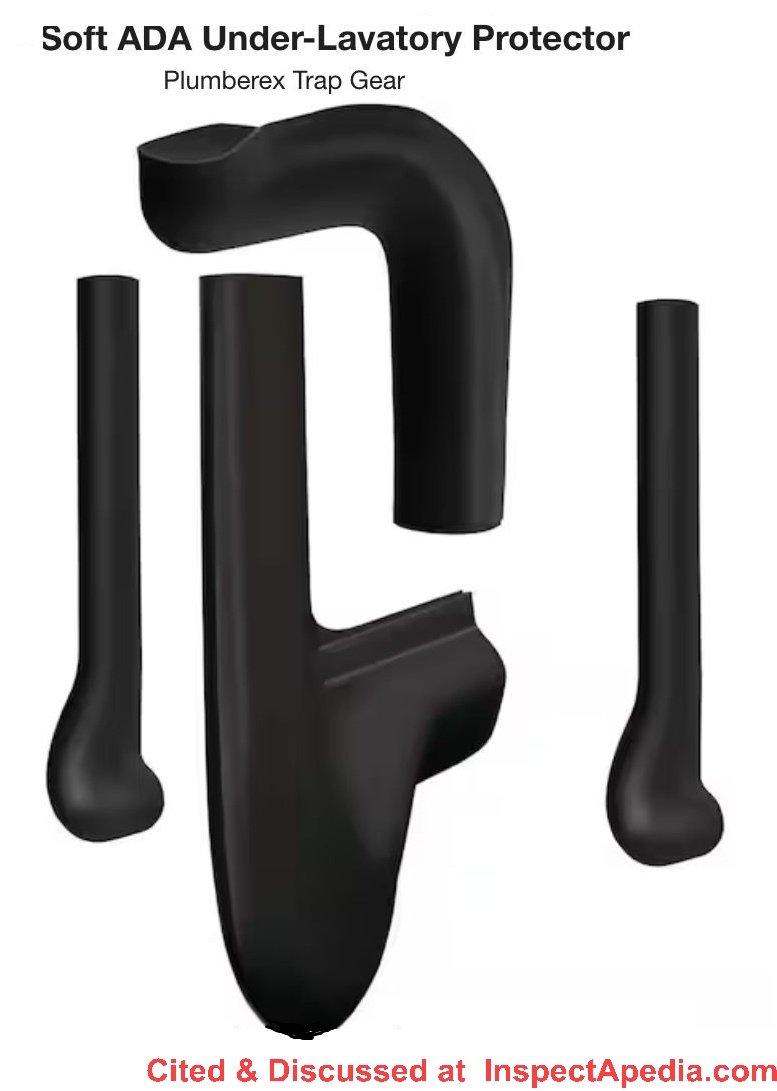
Reply by (mod) -
I would not expect a plumbing inspector to have passed the installation that you described for your AC condensate.
Where cool condensate drainage is causing condensation on the exterior of the drain line the risk is leaks into the attic floor causing mold contamination or in the long-term, building damage.
It shoud be trivial to add some snap-around foam insulation in that location. Plumberex trap insulation, sold at building supply stores like Home Depot or Lowes or Menards can provide insulation that is shaped to fit on the drain trap itself. If the insulation is a bit bigger than the trap dimensions that should still be okay.
Foam insulated condensate line is wet and leaks into ceiling
I have a condensate line (wrapped in foam) running to the havc unit in the ceiling above my bathtub. The insulation appeared to be damp and when I touched it water came pouring out. I gather this is not normal. any advice would be great. Thank you On 2016-06-20 by Becky
by (mod) -
Sounds as if the insulation is incomplete, with opernings permitting moist air in contact with cold refrigerant line;
OR
There is a leak in the condensate drain line itself.
I'd inspect the piping for a leak and if it's not actually leaking then be sure that the insulation is complete.
Watch out: leaks into a ceiling risk hidden mold contamination, so during your drain line repair be sure to inspect for moldy drywall or mold on wood surfaces such as ceiling framing or the underside of the wooden subfloor above.
...
Condensate Drain Inspection FAQs
Crimped rubber hose drain line caused condensate leak and expensive damage to walls and floors
My Air Condition Core was replaced and they used rubber hose which I found out 2 years later was crimped and sliced because of a piece of metal it was pushed into.
This has cause drainage on my wall and now my walls and flooring need to be replaced. They also pushed the drainage hose through flooring which drains into my crawspace eroding dirt under home and causing mold. Technician said they met requirements. Is this true? On 2017-09-06 by Joan
Reply by (mod) -
Joan
With the apology that no one can provide a for-certain answer to a serious building condition based simply on a brief e-text, and that an onsite expert will always find more, important information, it does not sound to me like the condensate drain installation you describe is proper nor that it would meet typical building codes.Your local plumbing or building inspector is the final legal authority on that question, but in general we would not expect approval of simply dumping condensate into a crawl area: the risks include mold, legionnaire's disease, insect damage, rot, even structural damage.
Is this condensate drain installation correct?
Could you please tell me if the drain for my hvac system is correct - photos above and below. On 2018-05-16 by Kari -
Im very concerned , haven't been well. Do I hire a plumber or hvac technician to correct the problem?
Reply by (mod) - not correct: wrong slope, no condensate drain trap, no cleanout - this is a trivial plumbing repair
I really can't see most of your AC condensate drain system, Kari.
But back up under the unit it looks as if the drain line angles up-hill: I'm not sure how that's going to work without leaks.
And of course there's no trap on your condensate line.
Doesn't look "correct" to me.
I would not be ***Very*** concerned, but I would want the condensate line properly trapped and routed so that it slopes continuously from exit to drain point. If you can't do that by gravity then you'll want to install a condensate pump.
by Kari
Thank you! I guess I need to hire someone because it doesn't make sense to me lol. I am worried , been ill stomach bothering me & my Husband recently passed away similar symptoms.
The system is electric but pipe goes into floor & I guess foundation but not sure
Thank you for your help. Karkens@aol.comby (mod) - Condensate, like any wastewater, flows by gravity downhill
Condensate, like any wastewater, flows by gravity downhill - or down-slope. If a pipe drops down out of your air conditioner air handler then aims uphill it will either not drain at all (depending on how high it runs) or even if it drains, it will always hold condensate inside the pipe - inviting bacterial growth and thus potentially contaminating the air handler.
When we add that there is no trap back at the air handler there is risk of sucking droplets of contaminated water back into the air handler when the blower runs.It's a poor installation, easily fixed either by rerouting the piping or by adding a condensate pump and a trap at the air handler.
You are welcome to let me know what's proposed to you or to ask further questions.
This should not be a big repair. It's trivial plumbing.
What is the correct height of a condensation drain line hanging over a floor drain?
What is the correct height of a condensation drain line hanging over a floor drain? Is it 1" or 2"? On 2018-01-18 by Jose
Reply by (mod) -
Jose
I don't think that height difference is substantive. 1-2" is OK. as long as there is ready access to inspect or clean or repair the drain and trap.
Sean
Where freezing is a concern, and assuming your system will be producing condensate during cold weather, I'd prefer to intercept the condensate indoors at the air handler, where I'd install a condensate pump to send condensate to a suitable indoor drain or outdoor disposal point having routed the piping through heated space.
If you have to run that through a freeze-prone crawl space you may need to use a heating tape.
Note that current best practice for most geographic areas has us convert a vented crawl area from a cold damp problem source under a building to a dry, heated, conditioned space.
Is it okay if the condensate line is connected directly to the plumbing drain vent pipe?
Is it okay if the condensate line is connected to the plumbing drain vent pipe? We came to know about this in our inspection.
We got one house inspected and we saw that the condensate line is connected to plumbing drain - On 2016-11-03 by Kanchan
Rely by (mod) - No: sewer gas hazards may be caused by that connection
Kanchan see CONDENSATE DRAIN CONNECTED TO VENT PIPE
and you'll see there are sewer gas and other hazards.
...
Condensate Drain Disposal Outdoors, FAQs
Outside condensate disposal blocked by sand
I bought a new house and the first floor is on a slab and the AC drain line drains outside.
My problem is the drain line is below the grade and I live in a sand area. When it rains, the drain line get covered up with sand.
I have built a concrete block well around the drain line but I need to raise it up higher, the concrete blocks. Is there anything else that I can do? On 2016-08-09 by Dan
Reply by (mod) -
Yes Dan, you could add a condensate pump and pump the condensate out through a line that's high enough that where it discharges it won't get sand-covered.
See more advice
at CONDENSATE DISPOSAL OUTDOORS
Worried that condensate drainage may cause a sinkhole?
We have dual units in our house, both of which have a condensate drain outside that drips by the foundation (which has a small crawl space).
There are 4 PVC pipes draining and the previous owner had them going into a 5 gallon bucket which filled nearly daily in the hot Lowcountry SC summers.
I used PVC connections and elbows to combine all 4 pipes into a single 1" pipe that I have buried underground for about 12 feet at a slight slope (maybe 3 inches over that length).
It drains underground into my flower border, 6 feet or so from the front porch. Now that summer is upon us and 100 degree days and the units run nonstop, the ground over a 2 foot diameter is saturated where the pipe drains.
Is this ok or will it cause any issues? I don't want to create a sinkhole or unforeseen issues! Thanks On 2015-06-17 by JW
by (mod) -
I'd be surprised if the volume of HVAC condensate from a residential system could be enough ever to cause a structural dangerous sinkhole
but if your particular site gives those concerns why not take a little more trouble to distribute the condensate over a wider area?
As our photo above shows, in new construction when the original backfill has not fully settled, condensate spillage can create a small "hole" next to the building foundation wall. Good practice would be to fill in the depression and slope the soil away from the building. - Daniel
...
A/C Condensate Drain Blocks & Clogs FAQs
Condensate drain to French drain blocked by vapor lock when the French Drain has Water
I have a big issue with my newly installed (01/16) American standard A/C system. I have a two stage condenser with a variable speed air handler. It replaced a Carrier system.
We used the existing condensate disposal drain line with a trap draining to the outside of the house.
The system would shutdown and the installing company said it was vapor lock?
They removed the trap and created a French drain with the drain line below grade.
The problem is hole fills with drain water that goes over the drain line and the system shuts down. I have to shop vac the water out of the hole daily to keep the system running. The dealer is of little help. Any suggestions? bparker11@tampabay.rr.com On 2016-07-07 y Bruce Parker
Reply by (mod) - install a condensate drain pump to send condensate to a working disposal point
There are indeed systems that will shut down an A/C system when condensate is not draining properly, in particular, when an attic-located air handler drains condensate into a drip tray that in turn drains into a disposal drain system.
If the drip tray accumulates water a small float switch shuts off the system to prevent a clogged condensate drain from overflowing into the attic floor.
But your drain system sound entirely different, and incompetent.A "French drain" - by which I am guessing you mean a perforated pipe buried in a gravel trench outside of a building - sounds rather an extreme method to dispose of A/C condensate.
Why wouldn't an installer simply use a condensate drain pump that pumps the condensate to an acceptable destination such as a plumbing waste drain or to the outside of the building?
In all events the drain system someone installed is not working; the installer has to return to either fix that problem or use a working alternative approved by local building code officials for disposal of condensate.
See CONDENSATE DRAIN LEAKS, CLOGGING, SLOPEby Bruce Parker
First off I really appreciate your thoughts and response. I do have the system you describe in your first paragraph with the air handler located in the attic and the appropriate float switches. But, the system would shut down even though the drain line was not backed up.
This was the so called vapor lock and it was attributed to the trap in the drain line as it exited the house. But the system had worked fine with the builders grade Carrier system for 8 years since the house was built.
Your definition of my French drain captures the concept. The installer did it to eliminate the trap and give the condensate a clear path out of the house. But when the drain pine is under water (the French drain hole fills up) the system shuts down. The dealer says the shutdown relates to a difference in construction on the American Standard. I'm trying hard to get a factory rep involved in this but so far no success.
by (mod) - define vapor lock and how to prevent condensate drain line vapor lock blockage
What I don't understand is what mechanism is closing off the system but my GUESS is that there is a float switch or similar device in the air handler's condensate collection pan. Vapor lock (explained below) causes backup of condensate until the float switch shuts down the air handler.
Definition of "Vapor lock on a condensate drain":
Vapor lock can oddur in an air conditioner or heat pump condensate drain line if air trapped in the drain system blocks the drain and then causes a backup.
How to prevent A/C system vapor lock on the condensate drain line
If your condensate drain line is properly sloped (continously at 1/8" to 1/4" per foot) you will not have vapor lock problems and the drain won't clog due to air bubbles and the A/C system won't shut down.
Your installer who eliminated a trap in the condensate drain system is asking for trouble: the purpose of the trap is specifically to avoid sucking harmful gases back into the air handler and blowing them onto occupants.
...
Condensate Drain Trap FAQs
Requirement for P-traps on AC condensate drain lines?
Regarding p-traps for condensate lines, can you weigh in on your thoughts about this? - On 2021-07-14 by Sarah
Reply by Inspectapedia Com Moderator
@ Sarah
Interesting article by Des Champs (cited and linked below) and thank you for the question about using a check valve as an alternative to using a P-trap on an air conditioner or heat pump condensate line.
Let's not forget the reason for traps on condensate lines: to avoid sucking noxious gases up into the building air-supply; So we want to trap the condensate drain line at the air handler.
The author does some fun analysis of water evaporation rates and so that leads to a concern that the water in the trap dries and the trap fails; If there's no water in the trap I suspect the air handler isn't being run - so no condensate is being produced - so we're not particularly drawing noxious gases into the building air through its duct system until the system is back on - and then condensate is usually produced pretty quickly.
There are, of course, fancier trap alternatives that will block back-flowing gases using a flapper trap; For floor drains - a similar problem - we simply pour some mineral oil into the trap. I'll look at the article again in more detail.
For other readers who, like me, are reluctant to click on off-site links to whoknowswhere, you can also see this article at by Nicholas DesChamps here at
HVAC, CHECK VALVE ALTERNATIVE to P-TRAP for HVAC CONDENSATE [PDF] (2020) - Des Champs, Nicholas, H., Ph.D., P.E., Fellow ASHRAE, HPAC Engineering, eNewsletter, Web: hpac.com - retrieved 2022/07/23, original source: https://www.hpac.com/piping-pumping/article/21130312/time-to-reconsider-use-of-ptraps-for-condensate-removal
The alternative device described by Dr. Des Champs is, in essence, a ball type check valve intended to permit condensate to drain and to avoid a potential back-up of sewer gases into the HVAC system air distribution (to building occupants), as an alternative to the traditional water-filled P-trap that is designed for that purpose.
OPINION: We agree with Des Champs that there is a known problem with loss of the water seal in traditional traps used on HVACR condensate disposal lines.
Des Champs also cites other advantages of waterless trap alternatives such as avoidance of the risk of freeze-damage and of collection of sludge that can accumulate in and clog a plumbing trap. Those are genuine problems that are indeed well recognized in the industry, enough that there are A/C condensate trap cleanout kits and traps that are designed to be easier to clean and others designed to protect their water seal from loss.
It is worth noting that the article includes some interesting and useful analysis of the rate of loss of water from a plumbing trap - nice work.
It's worth noting, too, that the author's company, DesChamps Technologies, designs and sells the type of product touted by the author, and that's the idea.
We'd have liked the article to have made more clear that if your HVAC condensate is NOT connected to a plumbing vent or sewer line or drain without an air-gap - which by code it should not be anyway - then, where the condensate drain isn't directly connected to building drain piping, the possibility of back-drafting nasty sewer gases up into the air handler through the condensate drain is essentially nil or zero.
We'd also like to see more data on the ability of a ball-type check valve to resist clogging or sticking from dust, debris, or algae that may enter the device from the air handler's condensate pan. Other experts warn about this problem:
"The first and most effective step for avoiding valve failure is keeping the pipeline and valves clean and free of debris. This can be achieved by installing filters and covers where required. Regular flushing of the piping system can also be performed to remove settled debris and minimize the buildup of contaminants."
- in "Thomasnet, PREVENTIVE MEASURES TO AVOID CHECK VALVE FAILURES, IN THE ESSENTIAL GUIDE TO PREVENTING CHECK VALVE FAILURE [PDF] (2018) Thomas Engineering, - retrieved 2022/07/23, original source: https://www.thomasnet.com/insights/guide-to-preventing-check-valve-failure/Please see details about proper condensate drain installation, problems, and avoiding trouble in the article series beginning at
CONDENSATE HANDLING, HVAC - home
and be sure to see also
where we'll ultimately move this discussion. Thanks again for a helpful question.
Followup by Sarah
Thanks so much, Dan. Thanks for all your input. Addressing your points:
We have one air handler that serves both the heating and the cooling side.
The gas furnace is directly on top of the air handler and the AC cooling coils are on top of that. The furnace has a condensate trap that’s part of the condensate capture system in the furnace itself.
The condensate from the furnace collector box and trap empties into a condensate line which is common with the line from the AC unit.
Per info in the link we shared, the AC condensate line experiences positive air pressure because the air handler blows air into it, which we observe at the tap point on the line. That would seem to mitigate the potential for odors intruding into the HVAC from the floor drain where the line empties.
On the other hand, during seasons when the AC and furnace sometimes run in alternating cycles there’s an unpleasant odor coming from our vents.
We found that, after much trial and error and multiple visits w/HVAC techs, that we can reduce, if not completely eliminate this odor by making sure the condensate line is extremely clean. This suggests there are various junctures when the air pressure in the line is negative and drawing odors into the HVAC system.
Due to the observations about evaporating water in P-traps, we are wondering if the ball valve promoted in the white paper would be appropriate to our system and would appreciate your thoughts.
Reply by Inspectapedia Com Moderator - Take a look at the Supco type waterless condensate drain trap
I want to say yes, or a chicken-hearted "yes if approved by your local plumbing inspector";
candidly: I don't have a sufficiently-clear understanding of your specific HVAC system nor just what units are producing condensate nor whether there is more than one condensate source (air conditioning vs. a condensing boiler?).
It certainly is easy enough to experiment with a temporary close-off of the existing condensate drain when you are in heating mode and assuming you are certain that there is no condensate to be disposed-of in that mode.
I'm unclear what "ball trap" you were considering.
But there are "waterless condensate traps" designed for your circumstance, like the SUPCO RLC051 that I show here, available from HVACR suppliers and approved for that use.
That ought to end the debate. And it ought to let you find out if the drain is truly the only odor source.
A/C Condensate drain throug trap to sewage ejector pump: I have to prime the trap?
Is it code to run the furnace humidifier drainage to a free standing pipe that goes to the ejector pump and sewer. A small pvc trap was created.
Was told I need to add water to pvc 2 inch pipe above trap every so often. This does not seem right to me.
There is a floor drain a few feet away that goes to the ejector pump too.
Seems like sewer gas is blowing through vent. I smell slight weird smell. What should I do? Worried about kids getting sick? What would be the proper way to do this? Spent $3100 so far. Please help. Just want this fixed On 2016-04-16 by Karen
by (mod) -
Karen:
All drain pipes connected to a sewer need to include a plumbing trap - otherwise dangerous sewer gases can enter the building.
A humidifier consumes water and evaporates it into the heating air of a furnace system.
A dehumidifier removes water from building air and needs to be drained.Because the volume of water entering a trap on a condensate drain varies and can stop completely when the A/C is not in use, your installer said to add water the trap. That's to prevent sewer gases from entering the building up through the dry plumbing trap.
FYI there are alternative condensate drain traps that don't need to be kept primed with water.
If there are sewer gases entering the home the source needs to be found and fixed; it ought not cost thousands of dollars - something is wrong with this picture.
...
...
Continue reading at CONDENSATE DRAIN CLEAN & DE-CLOG or select a topic from the closely-related articles below, or see the complete ARTICLE INDEX.
Or see this
HVAC Condensate Articles
- CONDENSATE HANDLING, HVAC - home
- CONDENSATE LEAKS
- CONDENSATE PUMPS
- CONDENSATE DISPOSAL, IMPROPER
- CONDENSATE DRAINS, CODES
- CONDENSATE DRAIN CLEAN & DE-CLOG
- CONDENSATE DRAIN INSULATION REQUIREMENTS
- CONDENSATE DRAIN PROBLEMS
- CONDENSATE DRIP TRAY DEFECTS
- CONDENSATE PAN SWITCH LOCKOUT
- Legionella BACTERIA & HVAC EQUIPMENT
- CONDENSING BOILER/FURNACE CONDENSATE DRAIN
- HARTFORD LOOP
- Legionella BACTERIA & HVAC EQUIPMENT
- SPLIT SYSTEM AC CONDENSATE LEAK REPAIR
- CONDENSING BOILER/FURNACE CONDENSATE DRAIN
Suggested citation for this web page
CONDENSATE DRAIN PROBLEM FAQs at InspectApedia.com - online encyclopedia of building & environmental inspection, testing, diagnosis, repair, & problem prevention advice.
Or see this
INDEX to RELATED ARTICLES: ARTICLE INDEX to AIR CONDITIONING & HEAT PUMPS
Or use the SEARCH BOX found below to Ask a Question or Search InspectApedia
Ask a Question or Search InspectApedia
Try the search box just below, or if you prefer, post a question or comment in the Comments box below and we will respond promptly.
Search the InspectApedia website
Note: appearance of your Comment below may be delayed: if your comment contains an image, photograph, web link, or text that looks to the software as if it might be a web link, your posting will appear after it has been approved by a moderator. Apologies for the delay.
Only one image can be added per comment but you can post as many comments, and therefore images, as you like.
You will not receive a notification when a response to your question has been posted.
Please bookmark this page to make it easy for you to check back for our response.
IF above you see "Comment Form is loading comments..." then COMMENT BOX - countable.ca / bawkbox.com IS NOT WORKING.
In any case you are welcome to send an email directly to us at InspectApedia.com at editor@inspectApedia.com
We'll reply to you directly. Please help us help you by noting, in your email, the URL of the InspectApedia page where you wanted to comment.
Citations & References
In addition to any citations in the article above, a full list is available on request.
- In addition to citations & references found in this article, see the research citations given at the end of the related articles found at our suggested
CONTINUE READING or RECOMMENDED ARTICLES.
- Carson, Dunlop & Associates Ltd., 120 Carlton Street Suite 407, Toronto ON M5A 4K2. Tel: (416) 964-9415 1-800-268-7070 Email: info@carsondunlop.com. Alan Carson is a past president of ASHI, the American Society of Home Inspectors.
Thanks to Alan Carson and Bob Dunlop, for permission for InspectAPedia to use text excerpts from The HOME REFERENCE BOOK - the Encyclopedia of Homes and to use illustrations from The ILLUSTRATED HOME .
Carson Dunlop Associates provides extensive home inspection education and report writing material. In gratitude we provide links to tsome Carson Dunlop Associates products and services.


